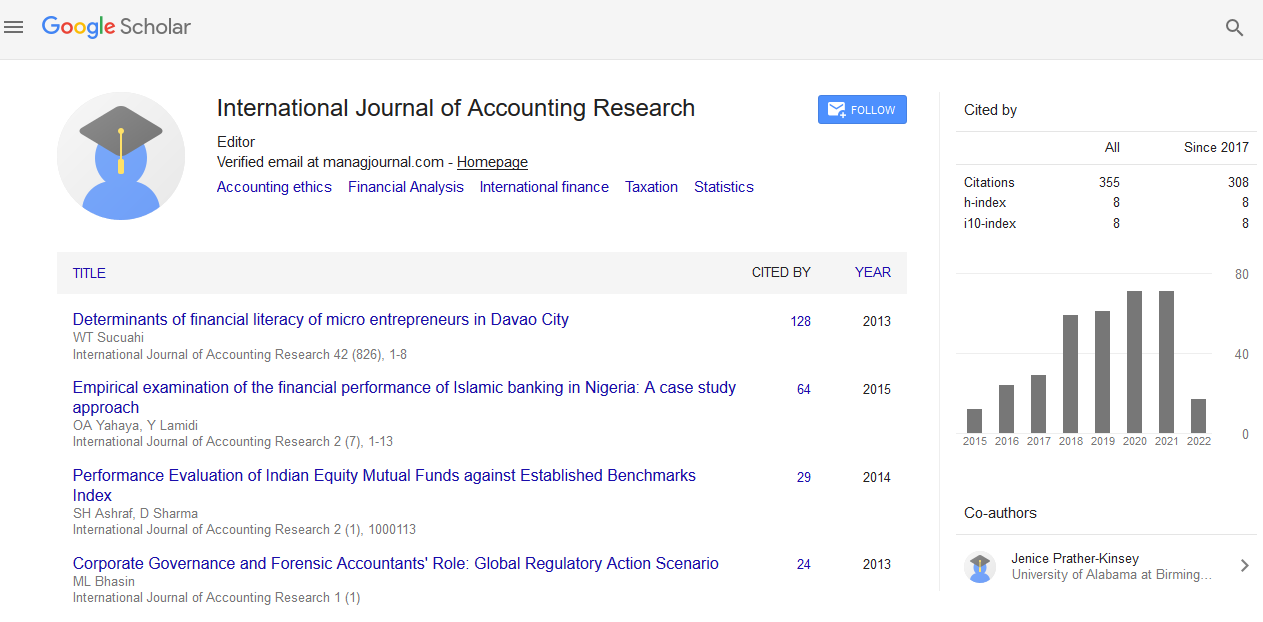Indexed In
- Open J Gate
- RefSeek
- Hamdard University
- EBSCO A-Z
- Scholarsteer
- Publons
- Euro Pub
- Google Scholar
Useful Links
Share This Page
Journal Flyer

Open Access Journals
- Agri and Aquaculture
- Biochemistry
- Bioinformatics & Systems Biology
- Business & Management
- Chemistry
- Clinical Sciences
- Engineering
- Food & Nutrition
- General Science
- Genetics & Molecular Biology
- Immunology & Microbiology
- Medical Sciences
- Neuroscience & Psychology
- Nursing & Health Care
- Pharmaceutical Sciences
Perspective - (2022) Volume 10, Issue 4
Consumer Credit & Banking Institution
Yong Zeng*Received: 01-Apr-2022, Manuscript No. IJAR-22-16696; Editor assigned: 05-Apr-2022, Pre QC No. IJAR-22-16696(PQ); Reviewed: 20-Apr-2022, QC No. IJAR-22-16696; Revised: 28-Apr-2022, Manuscript No. IJAR-22-16696(R); Published: 06-May-2022, DOI: 10.35248/2472-114X.22.10.269.
Description
The amount of credit available to a firm or individual from a financial institution in the form of loans is referred to as bank credit. The total amount of money a person or corporation can borrow from a bank or other financial institution is referred to as bank credit. Credit can also relate to a borrower's creditworthiness, or his or her capacity to repay the credit provided on time. Lenders give credit to individuals and businesses based on their belief that the borrower will repay the money they borrowed plus interest. The term "credit" is used in accounting to describe an accounting entry that reduces assets or increases liabilities on the balance sheet.
In the 1520s, the concept of credit was first used. Creditors in ancient times evaluated a potential borrower's creditworthiness only on the basis of his or her reputation before giving loan. Traders made loan decisions based on their personal ideas and beliefs about the borrower because the notion was not as advanced as it is today. Such a strategy was subjective, making it vulnerable to bias and manipulation, as well as excluding potentially trustworthy borrowers. In comparison to a subjective approach in the past, the process of analyzing the creditworthiness of a potential borrower now comprises a more objective approach. Rather of depending on personal views and opinions, creditors now examine a borrower's credit history by reviewing their credit report. Secured credit and unsecured credit are the two primary categories of bank credit. Secured credit is credit backed by an asset, such as a car, farm machinery, or a home, that serves as security for the loan. The lender places a lien on the asset pledged as security, and the borrower does not fully own the asset until the debt is entirely paid off. In the event of a borrower default, the lender has the right to seize the collateral asset to recuperate the losses. Unsecured credit, on the other hand, is not secured by anything, and the lender cannot seize any of the borrower's assets to force repayment. Unsecured credit lenders, on the other hand.
Consumer credit is defined as a form of personal credit in which an individual purchases goods or services without immediate payment. Some common examples of consumer credit include credit cards, short-term loans, personal loans, and more. Consumer credit is offered by banks, credit unions, and retailers, and borrowers are required to repay the loan over time with interest.
Trade credit is a form of credit that allows a customer to purchase goods from a seller with an agreement to pay the purchase price at an agreed future date. Most companies typically offer trade credit as part of the terms of the purchase agreement. However, customers who benefit from this arrangement must be financially stable and have a history of ontime credit repayment. Companies that offer trade credit terms allow 30 days, 60 days or 90 days for repayment and the transaction is invoiced. Some customers may be able to negotiate a longer trade credit repayment term, and approval of these terms depends on the merchant's criteria for trade credit eligibility.
A loan is a more flexible form of financing that allows you to access the loan amount, depending on your needs at any given time. The credit sets a maximum money limit that the customer can use in whole or in part. The customer can use all the money offered, some or not at all. Bank credit is commonly referred to as a loan that is granted for a company's or a customer's personal needs, with or without collateral or collateral, with the expectation of earning periodic interest on the amount of the loan.
Citation: Zeng Y (2022) Consumer Credit & Banking Institution. Int J Account Res. 10:269.
Copyright: © 2022 Zeng Y. This is an open-access article distributed under the terms of the Creative Commons Attribution License, which permits unrestricted use, distribution, and reproduction in any medium, provided the original author and source are credited.


